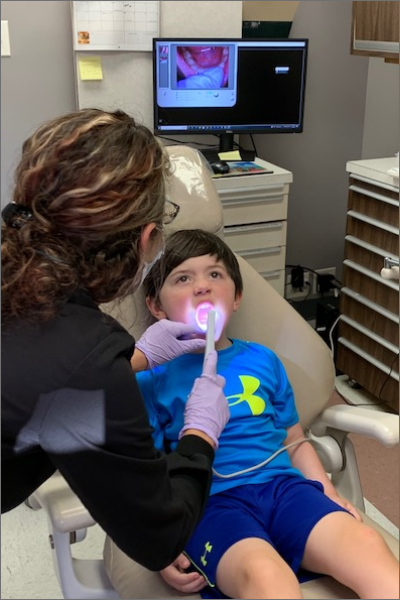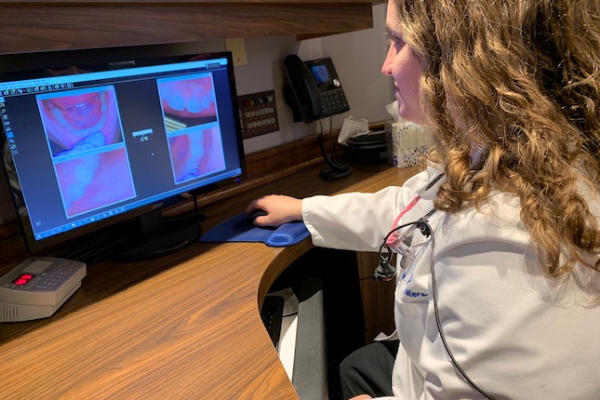This brief for Head Start staff shares basic information about how teledentistry works, using teledentistry in public health settings, the benefits of using it in Head Start programs, and tips for getting started.
Background
Everyone deserves to be healthy — to have a healthy mind, a healthy mouth, and a healthy body. Good oral health is important for overall health. Yet millions of Americans do not have access to oral health care. Disparities in oral health continue to exist, particularly among people with low incomes, those with a disability, and those who are members of minority groups or who live in areas without enough oral health professionals.
Teledentistry can facilitate the delivery of oral health care, including education, diagnosis of diseases, preventive care, and a limited level restorative care. It has been successful in Head Start programs in many states, including in California, Maine, Oregon, and Pennsylvania. Since the coronavirus (COVID-19) pandemic began in 2019, use of teledentistry has grown substantially throughout the country. Teledentistry is increasing access to oral health care for those who need it most.
 How Teledentistry Works
How Teledentistry Works
Teledentistry uses telecommunication technologies to allow people to receive oral health care from a dental hygienist in one physical location while a dentist supervises delivery of the care from another location. When dental offices were closed during the COVID-19 pandemic, many oral health professionals used teledentistry to provide oral health consultation and preventive care to patients.
Teledentistry laws and regulations, such as those indicating whether patient information and images must be examined in real time (synchronous) or can be stored and examined later (asynchronous), are established at the state level. Once a state enacts teledentistry legislation, typically the state dental board determines what oral health care is allowable using teledentistry and who can provide care. Several states have limited or extensive laws and regulations on the use of teledentistry. Among states with no specific teledentistry laws and regulations, teledentistry may be allowed under telehealth laws and regulations. To learn more about teledentistry laws and regulations in your state, contact your state dental board or state oral health program.
Using Teledentistry
Teledentistry can be used in many settings, including early childhood care and education programs, schools, and community health centers. Typically, a dental hygienist uses portable equipment to look into a child’s mouth for possible tooth decay or other problems and takes photos and/or X-rays of the child’s teeth and mouth. With a laptop, a tablet, or another electronic device, the dental hygienist sends the information and images to a dentist. All personal and clinical information sent to the dentist is kept private and secure in compliance with the Health Insurance Portability and Accountability Act (HIPAA) and the Family Educational Rights and Privacy Act.
The dentist reviews the information and images in real time or later to determine if oral health problems, such as tooth decay, are present. The dentist and dental hygienist develop a treatment plan for what oral health care should be provided.
Once a treatment plan has been developed, the dental hygienist can provide oral health care in a public health setting. State dental practice acts identify what types of oral health care dental hygienists are legally allowed to provide. Depending on the state, care may include:
- Photos and/or X-rays
- Dental cleaning
- Fluoride varnish application
- Silver diamine fluoride (SDF) application
If a parent is present, the dental hygienist may provide education on prevention and treatment needs and what oral health changes to expect as the child grows and develops.
Many times, oral health care provided during the teledentistry visit is all a child needs until the next dental visit. However, if oral disease is present and cannot be treated on site, the child will need to visit a dental office or clinic.
 The Benefits of Using Teledentistry
The Benefits of Using Teledentistry
The use of teledentistry can help Head Start programs meet Program Performance Standards that are relevant to oral health, including ensuring that children have a continuous source of accessible oral health care and receive the following services:
- Oral exams whose frequency is based on the state’s EPSDT dental periodicity schedule
- Preventive oral health care, including fluoride varnish and SDF applications
- Needed follow-up oral health care, based on findings of the oral exam
Children attending Head Start programs in frontier, rural, and underserved areas where it is difficult to access oral health care may benefit the most from teledentistry. With teledentistry, children can receive care in their community, which means they miss fewer school days for in-person dental visits. Teledentistry allows children to receive oral health care without going to a dental office or clinic unless oral disease is present and cannot be treated on site. This can be helpful for families who have to travel long distances, who don’t have access to transportation to get to a dental office or clinic, who lack child care for other children, or who have other difficulties with visiting a dental office or clinic.
Tips for Implementing Teledentistry
Using teledentistry in Head Start programs requires careful planning and collaboration. As a first step, program staff should consult their Health Services Advisory Committee (HSAC) to determine if children enrolled in their program would benefit from teledentistry. Staff and HSAC members can look at the percentage of children who have a regular source of oral health care, who are up to date with their state dental periodicity schedule, and who have received follow-up care, if needed. They can also review their community assessment to determine whether the number and location of dental offices and clinics and the number of dentists willing to provide care to children in Medicaid is appropriate.
If a program’s HSAC does not include a dentist or a dental hygienist as a member, the state dental hygienist liaison or a representative from a local, county, or state office of oral health may be able to assist in searching for someone who can serve. These oral health professionals can help Head Start staff navigate the clinical, legal, logistical, and security issues that need to be addressed when establishing teledentistry services.
Download a PDF version to print and share.
Read more:
Resource Type: Article
National Centers: Health, Behavioral Health, and Safety
Audience: Teachers and Caregivers
Series: Brush Up on Oral Health (BUOH)
Last Updated: February 11, 2025
